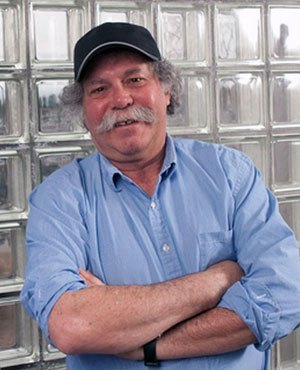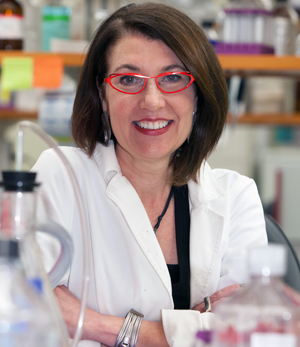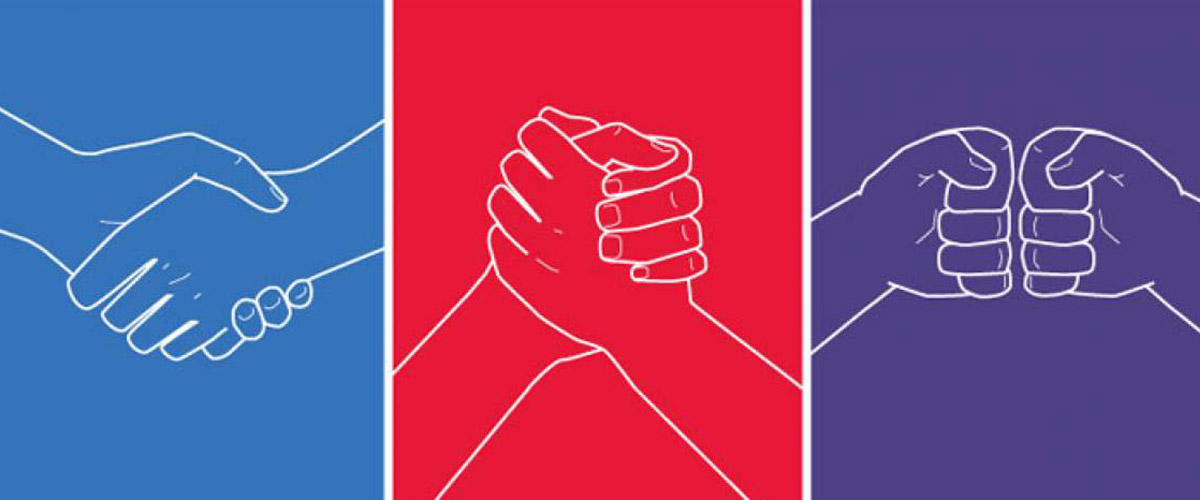Competition: It's the key ingredient in Olympic Games, capitalist economies, sibling rivalry and presidential races. It shapes relationships and geopolitics, keeps those who hate it awake at night and gets those who love it out of bed in the morning. It fuels progress in most fields of human endeavor including, of course, science: Think Tesla and Edison, Davy and Faraday, Hooke and Newton.
We would still be in the Dark Ages — perhaps even the Stone Age — were it not for the flip side of competition: collaboration. With arguably few exceptions, no scientist has ever made a meaningful contribution to her or his field in a vacuum (unless, of course, they were actually using a vacuum in the process).
This prominence of collaboration sets the world of science apart from the worlds of athletics and business.
"The first fundamental difference is we're all working toward the same goal, which is puzzling out how nature works," said National MagLab Director Greg Boebinger. "That is overwhelmingly why people go into science. We are naturally drawn to collaborate more than compete."
Having said that," he added, "we're human beings, and human beings like to compete. And we're also in a business where the people who discover something first get more credit for their work."
So … which is it? Should scientists be collaborative … or competitive?
We surveyed a number of scientists, and all agree: The answer is, a measure of both.
"Competition can be positive or negative," said Cathy Levenson, a professor of Biomedical Science & Neuroscience at Florida State University's College of Medicine. "Really, the right question is, what's the right balance between competition and collaboration?"
So, how do you strike the right balance? That answer is a bit of a moving target, and can depend on the personalities, ages and agendas of the people and institutions involved.
Competing breeds great work — or bad science
Levenson remembers fondly the long hours and late nights of her postdoctoral training at the National Institute on Aging. Knowing that another lab was tackling the same problem as her group was like caffeine: It kept her going.
"That level of competition — to get it out first — was a motivating factor to work fast and get it done," said Levenson. "It's kind of exciting."
Competition expedites science, a critical function for researchers eagerly awaiting the next discovery.
"I think competition is important in two ways," said Doug Bonn, a physics professor at the University of British Columbia. "One is that it can be a great motivator and helps quicken the pace of discovery. As long as people do not go so fast as to get sloppy, that is a good thing."
But when research devolves into a race to finish first, sloppiness is almost inevitable, argued physicist Al Migliori of the MagLab's Pulsed Field Facility in Los Alamos, New Mexico.

Al Migliori.
"I think that generates as many mistakes as good results," said Migliori. "If your goal is to be the first to figure this out, rather than [simply] to figure this out, then there is almost no way that you're not going to rush to conclusions, basically — rush to publish something that is not ready for prime time."
When scientists do let the lure of "first prize" compromise their work, competition kicks in again to set things right, said Bonn.
"If things do go too fast, that gets corrected by the second benefit of competition," said Bonn. "It leads people to do experiments that will confirm or disprove their competitors' work. This is at the heart of the checks and balances system in science."
While competition between groups can yield scientifically productive rivalry, it can also, when misdirected, have a poisonous effect on both people and results.
"I've also been in environments — not here at FSU, but in other places — where competition between team members, the internal competition, was so intense that it caused some bad behaviors," said Levenson.
In science as in most careers, people have their professional self-interest to consider, said Alex John London, a professor of philosophy and director of the Center for Ethics and Policy at Carnegie Mellon University. "They've got to make money and get promotions, get tenure or get the next grant."
But competition can go too far.
"You want competition where everyone is challenging each other to be better, to emulate each other, so that all boats rise because of the competition," said London. "What you don't want is competition where people are trying to elevate their status by taking somebody else down."
"A core challenge to regulation oversight and science policy," London added, "is to make sure those incentives aren't so great that it leads people to advance their own interests in ways that hurt their field or the larger enterprise."
Young researchers are generally allowed to hold some science secrets close to their lab coat pockets, at least for a little while. It's payback for long hours spent developing a new technique or piece of equipment.
"An early career researcher needs to guard a core of work that is demonstrably theirs," said Bonn. "But beyond that, both science and the individual researchers are, in my opinion, better served by collaborations in the long run."
Science institutions — whether research universities, private companies or labs – also have skin in the game. As the world's largest, highest-powered magnet lab, the National MagLab both works with and competes against other labs in Europe and Asia. Magnet science would be poorly served, noted Boebinger, by a magnet monopoly.
"My goal for the MagLab is that we remain the best, but in a very competitive environment," said Boebinger, who has been at the lab's helm since 2004. "It's often said that the worst scenario would be if there's a half dozen great labs and we're at the bottom of the list. But the second worst scenario would be to be the best magnet lab in the world — but also the only magnet lab in the world." Magnet science would be poorly served, noted Boebinger, by a magnet monopoly.
Collaborating to defeat the unknown
Physicist Migliori, a leading expert in a technique called resonant ultrasound spectroscopy, is passionate about his work. But he doesn't consider himself particularly competitive – about a 6 on a 1-to-10 scale. His research is about the science, he said – not about people exploring a similar topic at another lab. "When you discover something in science, it's just the most wonderful feeling," he said. "I don't need anybody else to tell me that I did well."
Collaboration, on the other hand, plays a large role in his work. "On the scale of 1 to 10, I'd make it 11," he said. "I think that I always learn something I needed to know and didn't know when I collaborate with smart people. And that just makes the science a lot better."
Still, you need to be strategic in your choice of partners, noted FSU's Levenson – for the sake of all involved. "You can waste a lot of time on collaboration," she said. "That wastes money, your time, graduate student time, postdoc time. The mutual intellectual interest in the scientific question would have to be the thing that would drive the decision for me."

Cathy Levenson.
Sometimes you have to wait for the right question, the right colleagues and the right moment to align.
"It took me a long time to develop good collaborations," said Levenson, adding that her best ones have been at the MagLab. "I went for many, many years as a faculty member without what I would call a meaningful collaboration because, for a collaboration to work, it has to be an intellectual collaboration, not just a technical collaboration."
One scientist who models the art of collaboration is UBC's Bonn, whose lab grows excellent crystals of a high-temperature superconductor sought after by scientists worldwide.
Bonn might have chosen to limit access to his treasures and, in so doing, more closely control the science. Instead, he has shared them with a wide group of scientists who poke, prod and analyze them in different ways. Boebinger, a physicist who studies high-temperature superconductors in their non-superconducting state, said science has advanced faster as a result.
At the end of the day, that's the goal. "No group in the world can do all possible types of measurements," said Bonn. "So we must collaborate to make progress and critically test ideas."
The fact that science has exploded into so many new techniques, instruments and sub-specialties almost necessitates collaboration, noted Lucio Frydman, chief scientist for chemistry and biology at the MagLab. With increasingly narrow areas of expertise, researchers need other minds to fill in the blanks.
"Making new inroads in modern science requires sharing resources, ideas and achievements among numerous different disciplines," said Frydman, who specializes in magnetic resonance. "Setting up such collaborations is also relatively easy these days, and sharing the achievement of the findings is also fairly easy, as it is usually very clear what the contributions of every member of a team has been."
Collaboration plays a critical role for institutions, too, said Boebinger. As chairman of the Global High Field Forum, he works with the world's other magnet labs to improve magnet technology and better serve the experimental needs of the broad scientific community.
"We want to work with the other labs so that they can help make us stronger and we can help make them strong," said Boebinger, "so that we do have this community of magnet labs with capabilities that are seen as competitive."
After the MagLab developed a breakthrough technology that paved the way for stronger resistive magnets, for example, most of the world's other magnet labs adopted it. Scientists from these labs also serve on each other's review boards.
And they help each other build magnets — even when that means giving up a world record.
The High Field Magnet Lab in Nijmegen, The Netherlands, and the National MagLab have joined forces on a number of projects. The Nijmegen lab, for example, has tested components for one of the National MagLab's new magnet. And the National MagLab is assembling the superconducting coils for a new Dutch magnet that will generate a field equal to the MagLab's 45 tesla hybrid magnet, allowing Nijmegen to tie a world record the National MagLab has held for more than 15 years.
"During the project operation, there are no walls between the two labs. There's an open exchange of information," said Andries den Ouden, head of superconducting magnet technology at Nijmegen. "That also requires a certain state of mind or attitude that is inviting for other parties to come here to collaborate."
In science, when there is a good idea one place in the world, it's a good idea every place, because we're all working on one, common puzzle, said Boebinger. "And when it comes to technologies and techniques in magnetic fields, they will almost always translate from one lab to the next, and there's a real willingness and openness to share when the circumstances make sense."
In the face of this puzzle, it's important to encourage a climate in which collaboration and competition can both help solve it.
"As a mentor, that's the issue for me," said Levenson. "How do I create an environment that has enough competition in it that there's excitement about the science, and we're all working together to maybe compete against the question more than compete against other people? So you have this competitive collaboration."
Whether you call it competitive collaboration, collaborative competition or even "collabetition," it amounts to the same thing when you get the proportions right: good science.
By Kristen Coyne



